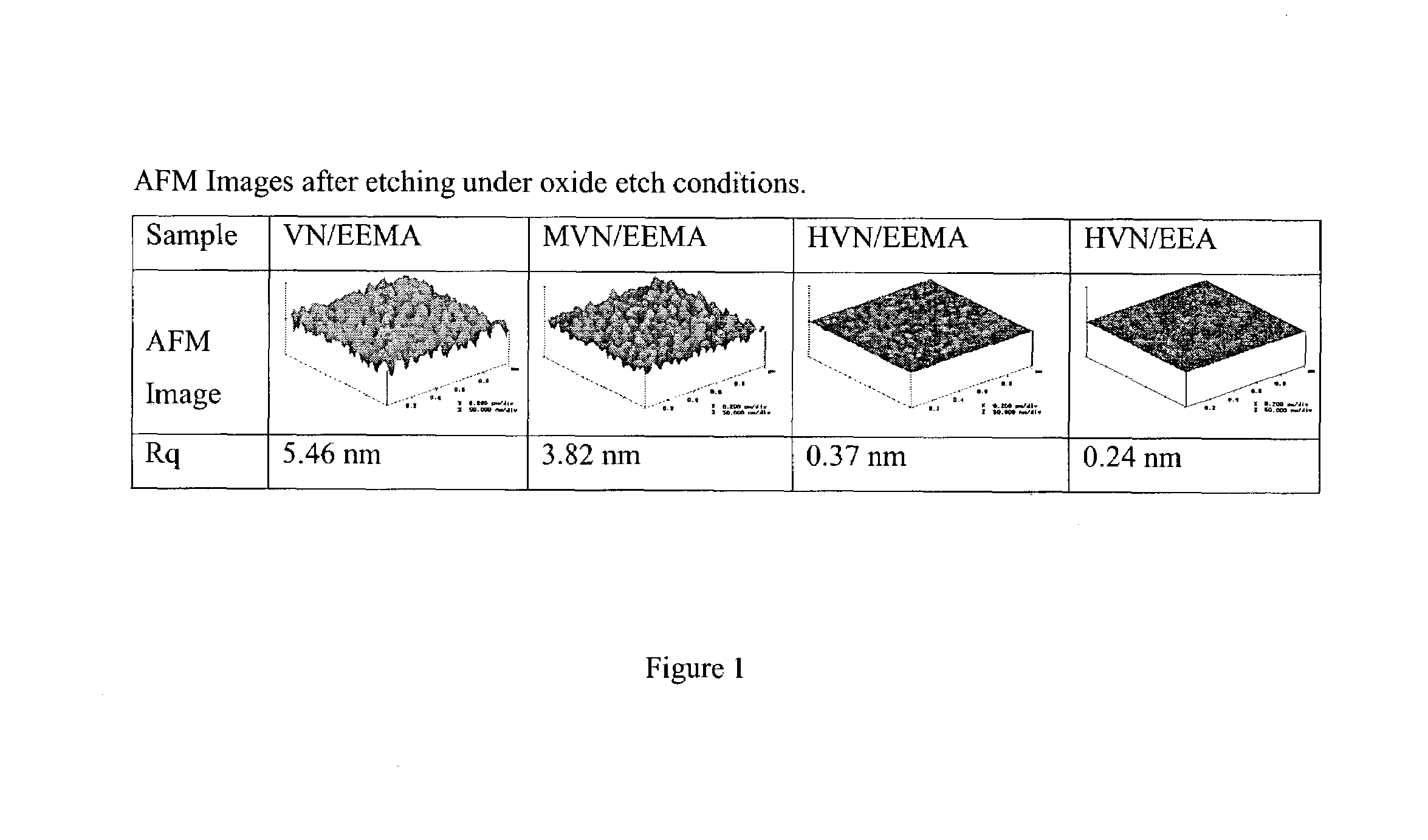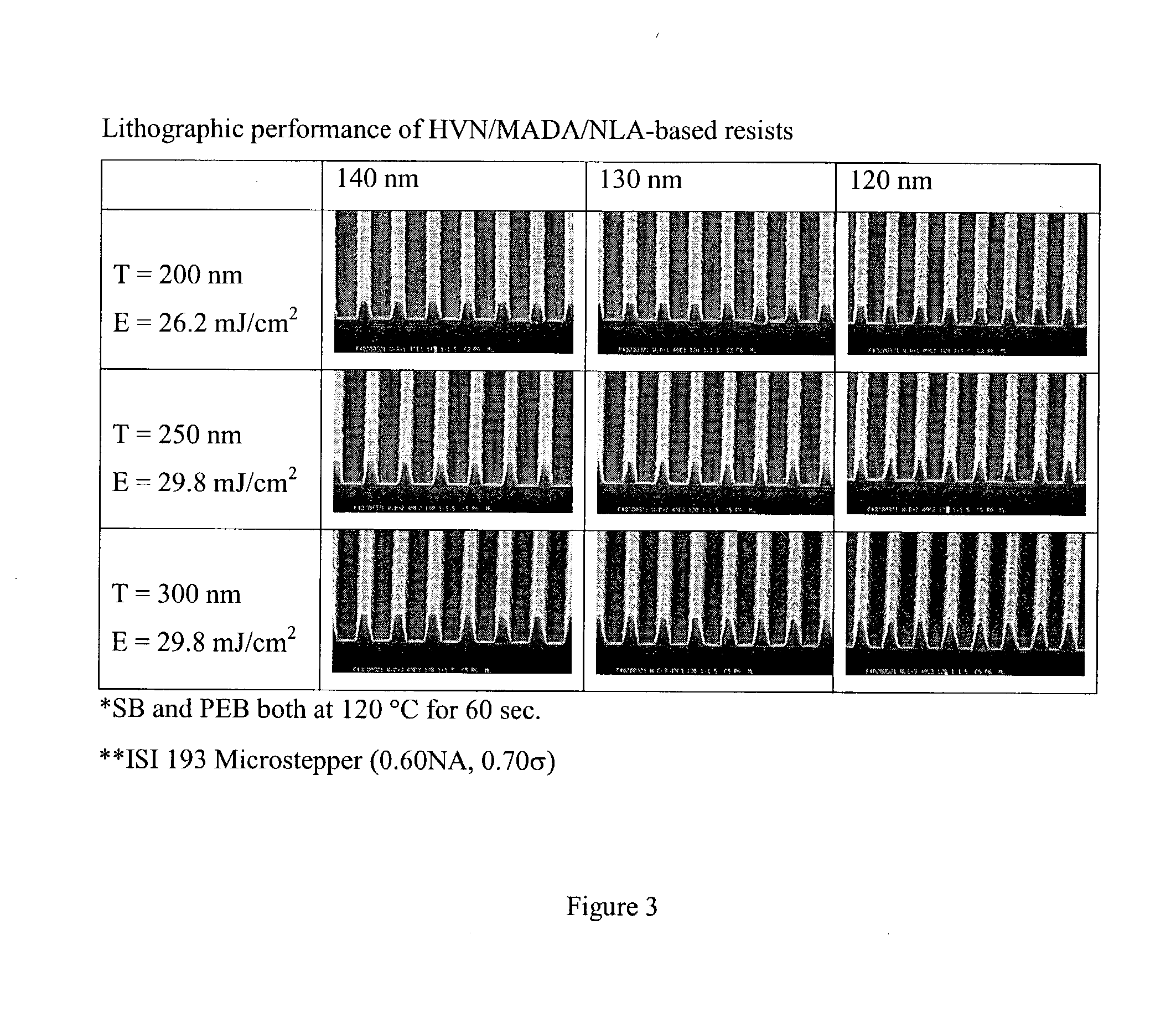Resins and photoresist compositions comprising same
a technology of resins and compositions, applied in the field of new resins, can solve the problems of reducing the resolution of patterned images, and achieve the effects of improving the lithographic performance of a photoresist, reducing the roughness of line edges, and enhancing smoothness
- Summary
- Abstract
- Description
- Claims
- Application Information
AI Technical Summary
Benefits of technology
Problems solved by technology
Method used
Image
Examples
example 1
Synthesis of 6-Hydroxy-2-Vinylnaphthalene (HVN)
[0075]The synthesis of 6-hydroxy-2-vinylnaphthalene (HVN) was carried out by three step reactions starting from 6-hydroxy-2-naphthaldehyde. In the first step, 6-hydroxy-2-naphthaldeyde (HNAL) was protected with ethyl vinyl ether to give 6-(1-ethoxy ethoxy)-2-naphthaldehyde (EENAL). This was followed by the Wittig reaction of EENAL to yield 6-(1-ethoxy ethoxy)-2-vinylnaphthalene. Finally, this was deprotected using pyridinium p-toluenesulfonate to yield 6-hydroxy-2-vinylnaphthalene (HVN).
[0076]6-(1-Ethoxy ethoxy)-2-naphthaldehyde. In a 500 mL three neck flask, equipped with a magnetic stirrer, an addition funnel, and a reflux condenser, were charged 25 g of HNAL (0.1462 mol) and 300 mL of ethyl acetate. 6-Hydroxy-2-naphthaldeyde was not completely soluble even after 3 h stirring at room temperature. To this was added 3.30 g of PPTS (0.0131 mol) and the solution mixture was heated to 70° C. At this temperature, 21 g of ethyl vinyl ether (...
example 2
Synthesis of HVN / MADA / NLA Terpolymer (Polymer Consisting of Polymerized Units of: 6-hydroxy-2-vinylnaphthalene (HVN); 2-methyl-2-adamantyl Acrylate (MADA); and acryloxy-norbornane-butyrolactone (NLA))
[0079]1.66 g of HVN, 4.29 g of 2-methyl-2-adamantyl acrylate (MADA), 4.05 g of acryloxy-norbornane-butyrolactone (NLA), and 0.2242 g of V601 (dimethyl-2,2-azodiisobutyrate) were dissolved in 30 mL of THF. This mixture was degassed by bubbling with nitrogen for 20 min and then placed in an oil bath kept at 75° C. to start polymerization. After polymerization for 12 h, the polymerization mixture was precipitated into hexane / isopropanol 80 / 20 v / v mixture. Second precipitation was carried out in hexane / isopropanol 50 / 50 v / v mixture. After filtration, a slight yellowish powder was obtained and this was dried in a vacuum oven at 50° C. overnight to yield 9 g of HVN / MADA / NLA terpolymer (90% yield).
[0080]Other copolymers were prepared using a similar procedure and results are summarized below. ...
example 3
[0082]A copolymer of 2-vinylnaphthalene (VN) and 1-ethoxy ethyl methacrylate (EEMA) with 60 mol % of VN was prepared. This copolymer was spin-coated on a Si wafer, etched under oxide etch conditions (C4F8 / Ar / CO / O2; 1500 W; 45 mT) for 60 sec, and then surface roughness was measured using atomic force microscopy (AFM). This copolymer exhibited the rms roughness (Rq) of 5.46 nm.
[0083]A further group of polymers were then prepared of the following components and surface roughness examined after etching under oxide etch conditions.
[0084]
[0085]These copolymers were spin-coated on Si wafers with film thickness ˜500 nm and then etched under oxide etch conditions for 60 sec. Under these conditions, 50˜100 nm of thickness loss was observed. The partially etched wafers were then examined using AFM to see the effect of substituents on post-etch roughness. Results are summarized in FIG. 1.
PUM
| Property | Measurement | Unit |
|---|---|---|
| Nanoscale particle size | aaaaa | aaaaa |
| Fraction | aaaaa | aaaaa |
| Composition | aaaaa | aaaaa |
Abstract
Description
Claims
Application Information
 Login to View More
Login to View More - R&D
- Intellectual Property
- Life Sciences
- Materials
- Tech Scout
- Unparalleled Data Quality
- Higher Quality Content
- 60% Fewer Hallucinations
Browse by: Latest US Patents, China's latest patents, Technical Efficacy Thesaurus, Application Domain, Technology Topic, Popular Technical Reports.
© 2025 PatSnap. All rights reserved.Legal|Privacy policy|Modern Slavery Act Transparency Statement|Sitemap|About US| Contact US: help@patsnap.com



